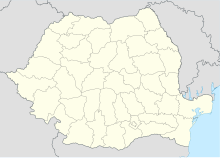Tăușoare-Zalion Reserve
| Tăușoare Cave | |
|---|---|
| Peștera Izvorul Tăușoarelor | |
 | |
| Location | Telciu, Rodna Mountains, Bistrița-Năsăud County, Romania |
| Coordinates | 47°26′34″N 24°31′45″E / 47.44278°N 24.52917°E |
| Depth | 413.5 m (1,357 ft) |
| Length | 20 km (12 mi) |
| Elevation | 950 m (3,120 ft) |
| Discovery | Leon Bârte (1955) |
| Entrances | 1 |
| Features | mirabilite, anthodites |
The Tăușoare-Zalion Reserve is a cave system located in the deeply forested areas of the Rodna Mountains, Bistrița-Năsăud County, in Romania.
The Tăușoare Cave was discovered in 1955 by a teacher, Leon Bârte. Located at an altitude of 950 metres (3,120 feet), it has a length of 20 km (12 mi) and a depth of 413.5 m (1,357 ft),[1][2] making it the deepest and the third longest cave in Romania.[2] The protected underground area covers 72.1 hectares (178 acres).[3]
The cave features rare minerals, such as mirabilite and anthodites, being second in Romania in value of anthodites, after the Peștera Vântului in the Pădurea Craiului Mountains.[2]
In 1986, geologists have found cave bear and brown bear bones in the cave. A few bones were transformed by the Palaeolithic man, who inhabited the cave, in tools. These were given to somebody to study and publish them, but nothing happened. Not even the informations from the 1988 article, which mentioned these, have made it to the archaeological literature.
References
[edit]- ^ "Peștera Tăușoare". complexulmuzealbn.ro (in Romanian). Bistrița-Năsăud Museum. Retrieved October 12, 2022.
- ^ a b c Gavrilă, Bianca Sara (July 28, 2013). "Cea mai adâncă peșteră și a treia ca lungime din țară, deschisă pentru prima dată publicului". Adevărul (in Romanian). Retrieved October 12, 2022.
- ^ "Peștera Tăușoare, reașezată pe palierul celor mai fascinante peșteri din România, printr-un proiect european". Răsunetul (in Romanian). June 22, 2015. Retrieved October 12, 2022.
External links
[edit]- Tăușoare-Zalion Reserve (archived at the Wayback Machine)
- National Agency for Protected Natural Areas - Romania


